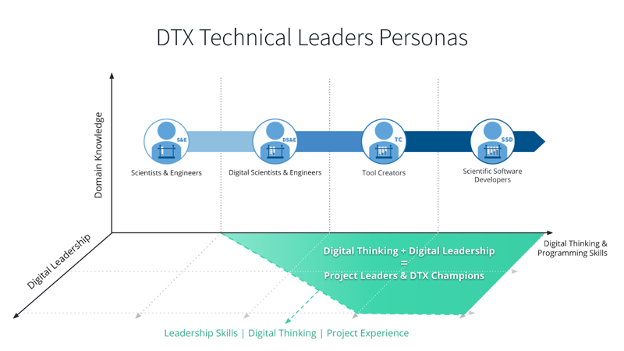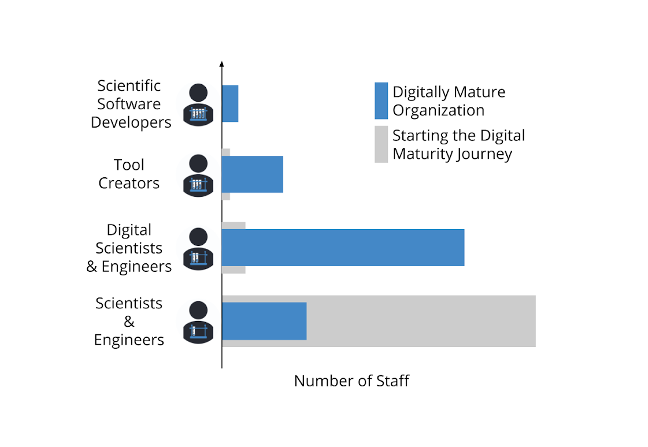Digital skills personas for success in digital transformation
The digital skills mix varies widely across companies, from those just starting to invest in digital transformation initiatives, to ones well into their journey. Building a community of people who think digitally and are able to innovate and quickly prototype ideas is key to delivering results.
Author: Alexandre Chabot-Leclerc, Ph.D., Vice President, Training Solutions
Identifying Digital Personas
Enthought defines digital transformation as a multi-year process of facilitating and accelerating an organization’s journey of increasing digital maturity, a journey that continuously delivers business results. To help guide companies in their journey, Enthought has created a framework consisting of 5 elements of digital maturity: digital strategy, digital skills, digital tools, data and data flow, and data infrastructure.
This blog post focuses on the Digital skills element. Digital skills, knowledge of scientific computing techniques and the possibilities they can create, are essential to execute on digital strategy and to leverage new technologies. To support digital skills development in digital transformation initiatives, a collection of personas has been formulated to define learning trajectories, inform team composition, support effective governance, and simplify communications.
A Personas Framework for Digital Transformation
Personas are names for different ranges of skills and competencies along three interdependent axes illustrated below: domain knowledge, digital thinking and programming skills, and digital leadership.

Development along the (scientific) domain knowledge axis accelerates during university, deepens in any graduate program, and grows further with additional specialization and science-driven work experience.
Growth along the digital thinking and programming skills axis is when a scientist becomes a “scientist who codes.” This skill can develop over multiple time horizons; from an early age, to university, to the work environment. The skill is most powerful when it has developed in parallel with scientific problem solving requiring creative thinking.
The third axis, digital leadership, is a crucial component of a digitally mature organization. Digital leaders have an acute sense of the possibilities enabled by digital skills and technologies. They manage projects where scientific software development in combination with the new generation of digital technologies is critical to success.
Creating Scientists Who Code
Consider the Scientists & Engineers of Figure 1 above, at the lowest digital skill level. They understand the data and computations they work with day-to-day, but use only commercial, specialist software, very often including Microsoft Excel. They become a Digital Scientist when they learn enough computer programming to implement solutions tailored to their problems, rather than being constrained by pre-packaged workflows in scripts or GUI apps. They’re able to create ad hoc analyses and reports that were not possible with the existing software tools. They increase their efficiency by automating tedious processes. Equipping scientists with these skills is one of the most popular programs delivered by the Enthought training organization.
These Digital Scientists can now take advantage of their new programming skills to quickly prototype and innovate, developing valuable new tools, measurements, and analyses that save time, reduce errors and risk, and enable new possibilities in their work. They learn to share their tools with coworkers, which multiplies their impact. This new persona is called a Tool Creator. Creating focused tools to solve business problems within a digital transformation is part of their responsibility. One of the most effective ways to develop this new persona is to immerse the Digital Scientist with a deep expert in scientific software development, working on one of their own problems, including AI/machine learning. This is a feature of the Enthought Technical Leaders Program.
Tool Creators develop further by learning from, and collaborating with, a community of peers doing similar work. They contribute to richer and more impactful tools. Some Tool Creators become Scientific Software Developers: expert programmers with deep scientific knowledge. They know how to engage fellow scientists to identify requirements and how to scope problems. Working with others, they enable new possibilities by developing custom solutions for their team, business unit and company.
Developing Technical Leaders
The development axes are interdependent; one needs digital thinking and at least some programming skills to understand the possibilities from the technology and develop digital leadership. At varying points, one can transition from one track to another as a part of natural career progression. Scientists and engineers can develop more leadership skills, and managers can develop more digital thinking and programming skills.
Project Leaders manage key projects where digital technologies and skills have the potential to deliver significant business results. They have domain knowledge and at least a minimum level of computational programming skills, so that they know what’s possible, even if they don’t code. This persona will have a digital thinking and programming skills at the level of Digital Engineers, Tool Creators, or Scientific Software Developers (the latter a unicorn).
Digital Transformation (DTX) Champions can identify where digital technologies can transform existing workflows and have the largest impact. They can map business value, prioritize projects according to their risk, costs, and business impact, and lead the execution of projects that take advantage of new technologies. DTX Champions are strong leaders, with deep technical knowledge and an excellent understanding of the business.
Teaching leadership is hard, especially when combined with digital capabilities. The Enthought experience from our Technical Leaders program is to create the conditions in digitally driven science projects where leadership can emerge.
The Skills Mix in a Digitally Mature Organization
Every organization has its own career ladder for their scientific community. The goal is not for every scientist and engineer to become a scientific software developer. However, companies do share a goal to raise the overall level of digital skills and leadership, as illustrated in the figure below. A higher overall digital maturity creates a community of practice for thinking digitally, which accelerates the rate of learning. Scientists and engineers are more likely to find innovative solutions to business problems, and implement them in a way that’s right for the business without being limited by third-party applications.

Creating New Possibilities
For science-based companies, the business results possible from digital transformation can only be realized if the community of domain experts core to the business have the skills required to develop solutions appropriate for their challenges. The second requirement is their leaders must know what’s possible with digital technologies, skills, and how to harness them.
For more than a decade, Enthought has been teaching scientific computing to scientists and engineers, enabling them to solve whole new classes of problems.
About the Author
Alexandre Chabot-Leclerc, Ph.D., Vice President, Training Solutions at Enthought, holds a Ph.D. in electrical engineering and a M.Sc. in acoustics engineering from the Technical University of Denmark and a B.Eng. in electrical engineering from the Université de Sherbrooke.
Related Content
コンカレント材料設計:AIで実現する次世代アプローチ
AIの高度最適化、生成AI、エージェント型AIの活用により、材料と製品を同時に設計・最適化するコンカレント材料設計についてご紹介します。開発スピードと自由度が飛躍的に向上させることで、性能向上や市場投入までの期間短縮、競争優位性の確立が可能となります。
「収益性の壁」を超える:AIの活用で機能性材料開発を戦略から再構築
スペシャルティケミカルおよび素材産業は、コモディティ化と価格競争の激化により、従来の差別化戦略では持続的成長が難しくなっています。こうした中、AIやマテリアルズインフォマティクス(MI)などの先端技術が、R&D戦略の再構築と成長再加速への有力な打ち手として注目されています。
研究開発組織の変革を成功させるためのパートナー選び
現在の競争が激しいR&D環境において、適切なテクノロジーパートナーを選ぶことは、組織にとって最も重要な意思決定の1つです。理想的なパートナーとは、単なるツールベンダーやシステムインテグレーターではなく、生産性を向上させ、イノベーションを加速し、競争力を引き出す解決策を提供する科学的な専門知識と戦略的な洞察を兼ね備えた「変革の同志」です。
「AIスーパー・モデル」が材料研究開発を革新する
近年、計算能力と人工知能の進化により、材料科学や化学の研究・製品開発に変革がもたらされています。エンソートは常に最先端のツールを探求しており、研究開発の新たなステージに引き上げる可能性を持つマテリアルズインフォマティクス(MI)分野での新技術を注視しています。
デジタルトランスフォーメーション vs. デジタルエンハンスメント: 研究開発における技術イニシアティブのフレームワーク
生成AIの登場により、研究開発の方法が革新され、前例のない速さで新しい科学的発見が生まれる時代が到来しました。研究開発におけるデジタル技術の導入は、競争力を向上させることが証明されており、企業が従来のシステムやプロセスに固執することはリスクとなります。デジタルトランスフォーメーションは、科学主導の企業にとってもはや避けられない取り組みです。
産業用の材料と化学研究開発におけるLLMの活用
大規模言語モデル(LLM)は、すべての材料および化学研究開発組織の技術ソリューションセットに含むべき魅力的なツールであり、変革をもたらす可能性を秘めています。
科学研究開発における効率の重要性
今日、新しい発見や技術が生まれるスピードは驚くほど速くなっており、市場での独占期間が大幅に短縮されています。企業は互いに競争するだけでなく、時間との戦いにも直面しており、新しいイノベーションを最初に発見し、特許を取得し、市場に出すためにしのぎを削っています。
R&D イノベーションサミット2024「研究開発におけるAIの大規模活用に向けて – デジタル環境で勝ち残る研究開発組織への変革」開催レポート
去る2024年5月30日に、近年注目のAIの大規模活用をテーマに、エンソート主催のプライベートイベントがミッドタウン日比谷6FのBASE Qで開催されました。
科学研究開発における小規模データの最大活用
多くの伝統的なイノベーション主導の組織では、科学データは特定の短期的な研究質問に答えるために生成され、その後は知的財産を保護するためにアーカイブされます。しかし、将来的にデータを再利用して他の関連する質問に活用することにはあまり注意が払われません。